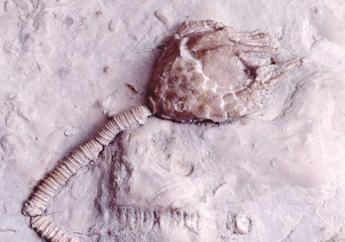Missouri Geological Survey Director: Carey Bridges, RG
A fossil does not always represent a type of plant or animal that lived a long time ago and is now extinct. Missouri’s most common fossil, a Crinoid is no longer abundant, but it does have more than 600 living relatives in the warm, clear waters of the Pacific and Indian oceans, and in the Caribbean Sea.

Crinoids comprise a highly varied group of echinoderm invertebrate animals that have inhabited the shallow to abyssal marine environment from the beginning of the Ordovician Period of geologic time (490 million years ago) to present day. Crinoids have a plant-like appearance and are often called “Sea Lilies” because of that resemblance; however, they are not plants. Crinoids have a five-point radial symmetry and are related to other echinoderms, such as the starfish, sea urchin and sand dollar. They are considered to possess the most complex anatomy of all marine invertebrates and like their starfish cousins, crinoids have been studied extensively because they can regenerate tissue, organs and even limbs.
Crinoids thrived during the Paleozoic Era (490 through 250 million years ago) and reached their apex during the Mississippian Period (360 through 320 million years ago). For millions of years, crinoids covered the ocean floor. Thousands of species of crinoids evolved and became extinct through geologic time. They, along with 96% of all marine life on the planet, perished during the mass extinction event called “The Great Dying,” which occurred at the end of the Permian Period, roughly 251 million years ago.
Most often, crinoid fossils are found in limestone as dismembered pieces with their individual hard parts preserved. These parts of their bodies (called ossicles), consist of their segmented column (“stem” that resembles a stack of poker chips), segmented calyx (“cup” that contained vital organs), and ambulacra (segmented feeding arms) that radiated out from the calyx and were covered with cilia (tiny hairs). The bottom of the stem was equipped with a fingered holdfast used to attach the animal to the sea floor. They could release the holdfast and float along to a new location. When fossilized crinoid stems weather out of the host rock, they often appear as tiny round discs of stone that may have a hole (often starshaped) in their center. These discs resemble beads and can be strung as such. The Mississippian-Age Burlington Limestone, a rock formation found throughout Missouri, is renowned for its abundant crinoid fossils. The crinoid Delocrinus missouriensis became the state’s official fossil June 16, 1989, after a group of Lee’s Summit school students worked through the legislative process to incorporate it as a state symbol.
Crinoids and other fossils are on display in our Ed Clark Museum of Missouri Geology. They also are found in the limestone walls of the Capitol in Jefferson City.
Nothing in this document may be used to implement any enforcement action or levy any penalty unless promulgated by rule under chapter 536 or authorized by statute.
For more information
Geological Survey Program
Missouri Geological Survey
P.O. Box 250
Rolla, MO 65402-0250
United States
